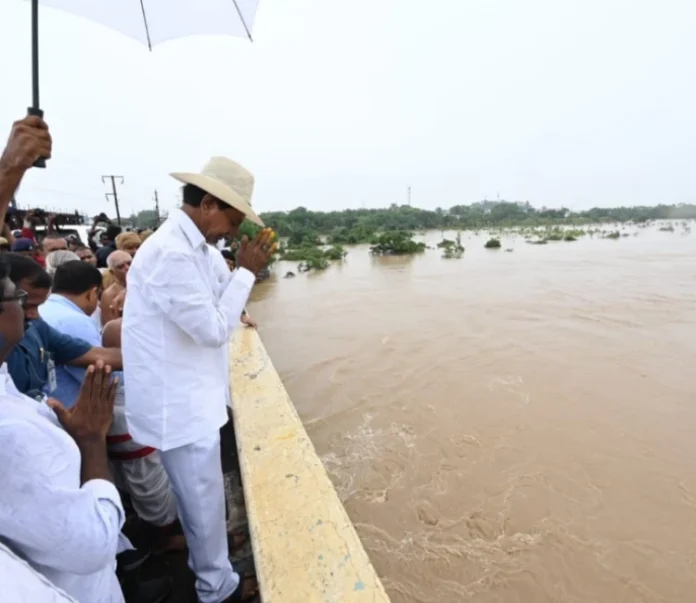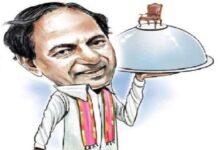Now, flood situation is quite stable in Telangana districts but the politics always makes a way in Telangana CM KCR’s mind. He always finds a way to poke through burning topics using a political weapon. This time KCR focused on Bhadrachalam or Bhadradi floods and the political story goes on. #KhabarLive tried to show you the reason on bifurcation backdrop, what’s in KCR mind.
The turn of events following the recent Bhadrachalam or Bhadradi floods point to a distinct possibility of Telangana Chief Minister K Chandrasekhar Rao using them to the hilt to score political brownie points by stoking anti-Andhra feelings. Most parts of the temple town of Bhadrachalam, where lakhs of devotees seek Lord Rama’s blessings, went to Telangana State during bifurcation of the combined state of Andhra Pradesh following pressure mounted by KCR on the Union government. The temple town had been part of the erstwhile composite state of Madras, prior to the formation of Andhra state in 1953. In those days, Bhadrachalam was in East Godavari district, with the natural boundary of Godavari River leaving the erstwhile Hyderabad State on the other side.
So, it was suggested to Union government to include Bhadrachalam in the new state of Telangana considering combined Andhra Pradesh has been home to two prominent temples — Tirupati and Bhadrachalam. Although Bhadrachalam was made part of Telangana, seven revenue mandals in Bhadrachalam division were made part of Andhra Pradesh by the Union government through an Ordinance in the first week of June, 2014 — a couple of days after the formation of Telangana State.
This ordinance was issued at the behest of N. Chandrababu Naidu who took the reins of the residuary state of Andhra Pradesh on 8 June, 2014. He had informed the Union government headed by Narendra Modi that those seven revenue mandals could be submerged in the Godavari waters following the construction of multi-purpose project Polavaram project; hence, the villages may be merged with AP. He did this even before taking oath as the Chief Minister of the residuary state.Given the present grim Bhadrachalam flood situation, it is but natural for people to form an opinion that this would be a regular feature upon construction of the Polavaram project as per the modified plan. The TRS would find it easy to build a case against the Polavaram project on the ground that there is need to save Bhadrachalam from perennial floods caused by the backwaters of the Polavaram due to its ‘abnormal’ height of 45.7 metres.
In fact, the height of the Polavaram project had been approved by the Central Water Commission in consultation with Telangana. Still, Telangana may now seek reduction of the height of Polavaram project to save Bhadrachalam from ‘perennial floods’. In that eventuality, the seven revenue mandals in question should be returned to Telangana. Minister P. Ajay Kumar of Khammam district has demanded that the areas of submergence be given back to Telangana, while limiting the height of Polavaram project. This being the bone of contention between the two states, it has now come in handy for TRS to raise its voice against the Andhra government with a dash of regionalism.
Stoking anti-Andhra sentiments in the minds of Telangana people in the name of state’s interests has always yielded good results for TRS. It may prove to be a benevolent factor for the TRS at the hustings tomorrow. The TRS government is already on the defensive with regard to the Kaleswaram project. The tremendous damage caused to the huge Bahubali engines during the recent floods has painted the TRS government in bad light. It is now clear that KLIP requires huge maintenance expenditure of a recurring nature.
The original project was envisaged during the YS Rajasekhara Reddy regime with an outlay of Rs. 30,000 cr, but had to be shelved for various reasons. After the formation of TS, KCR modified the project contours, gave it a new name, and increased the estimated cost to Rs. one lakh crores. Former IAS officers N. Jayaprakash Narayana (ex MLA also) and Akunuri Murali categorically stated that the Kaleswaram project was unviable as the expenditure required for its maintenance would be far more than the yield per acre of land benefiting from the project. For example, it will cost Rs. 50,000 for providing irrigation water for an acre of cultivable agricultural land. But the possible yield from the same acre of land will be just Rs.10,000. This cost differential has been the crux of the study conducted by various people on the Kaleswaram project. It is a different matter that KCR had brushed aside all such arguments and fumed at those who had raised their voices against the said project.
The case for return of seven mandals has become a face-saving device for the TRS government in the context of damage caused to Kaleswaram pumps. KCR is having good rapport with his Andhra Pradesh counterpart YS Jaganmohan Reddy. Jagan’s sister and YSRTP president YS Sharmila had questioned KCR on why he did not ask Jagan about the Polavaram project that had brought sorrow to people in Telangana areas.
In this backdrop, it will be interesting to see how KCR handles the recent Godavari floods, described as unprecedented in the last 100 years, for political gains. #KhabarLive #hydnews







